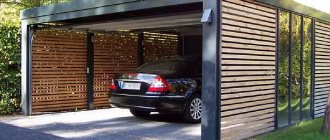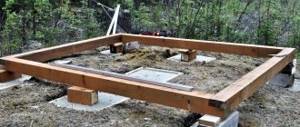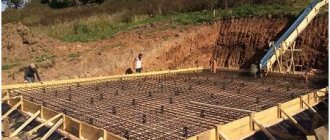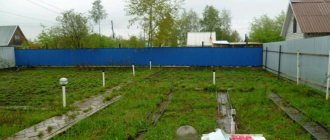Bathhouse construction and distances
When erecting buildings on your yard, including bathhouses, you should be guided by the technical, legal and urban planning standards enshrined in the provisions:
- on the rules for planning and placing buildings on the territory of a household: SNiP 30-02-97 and SP 53.13330.2019;
- on the requirements, procedure for development and execution of a development project: SP 11-106-97.
Unauthorized buildings or early buildings where the law has been violated pose a threat to neighboring housing developments and can be demolished by court decision. No changes in this regard have been adopted for 2020-2021.
In the village
The Town Planning Code classifies a bath-type building as an auxiliary building.
The purpose of such a facility under construction is associated with an increased danger for surrounding buildings. This is due to the following:
- use of stove heating;
- the likelihood of violations during the installation of the chimney or its untimely maintenance;
- environmental pollution associated with improperly organized wastewater disposal.
SNiP standards define the essence that a well for collecting wastewater and human waste must be located at a distance of at least 8 meters from residential buildings. Its design provides for the possibility of periodic cleaning and maintenance of the collection. Due to non-compliance with this construction norm, conflicts often broke out between neighbors in villages, hamlets and rural settlements.
Sauna
If legal claims arise, knowledge of the provisions of building codes and rules for individual housing construction (IHC), for a dacha non-profit partnership (DNT) and a non-profit garden partnership (SNT) will help resolve the issue of protecting personal interests.
Installation of different types of baths
Before erecting a structure, it is important to determine the type of future construction. Baths can be smoky or non-smoky, therefore, according to the regulations, the requirements for the first type of structure are as follows:
- Build taking into account the wind rose, since the wind can strongly blow smoke towards neighboring houses.
- Do not build in densely populated areas.
- Maintain a distance of 12 m from the bathhouse to the residential building.
Interior
If you plan to build a bathhouse that needs to be heated, then the distance from this building to the country house should be kept at 12 m. It is better if the building is located on the side of the site where the wind blows more intensely and frequently. This will further reduce the risk of fire hazard.
Smoke-free baths, or white baths, must be installed taking into account sanitary standards:
- away from the neighbor's house;
- arrange a ventilation system;
- waterproof the steam room.
Installing a building in white will significantly provide savings on the arrangement of a water supply system and sewerage system on one site. There are no norms in the legislation that prevent the placement of sauna structures together with residential buildings. In any case, it is better to coordinate such projects with architects and design specialists.
Combination of baths and other buildings
Modern baths are often combined with a garage structure, a residential building or a summer house. The legislation does not indicate anywhere that the construction of such structures is prohibited by regulations. Sanitary standards apply only to the construction of washrooms or toilets.
Location on
The distance from the bathhouse to the house is established by SNiP, SP and SanPiN standards. All standards have been developed for free-standing structures. A steam room in the form of a Finnish sauna is an extension, the operation of which is associated with certain risks:
- fire hazard;
- ingress of wastewater into the ground;
- soil contamination.
Fire standards for the distance from a bathhouse to various buildings are similar to sanitary standards, which are regulated by SNiP 30-02-97 as amended in 2021 and SP 53.13330.2011. Fire safety standards have not been established for grouped buildings and structures, including those located in neighboring areas.
Removing buildings based on material of manufacture
The distance between the main and auxiliary building buildings determined by the standards prevents the transfer of flame to neighboring buildings in the event of a fire. This takes into account the material from which they are made, as well as the possibility of approaching them around the perimeter. That is, at the design stage, any factors that impede the provision of assistance in the event of an emergency are excluded.
Country cottage area
What distance should be between permanent buildings on your own and neighboring plots is indicated in the list below:
- Between stone, cast concrete, prefabricated reinforced concrete – 6 meters.
- The above type, but with floors made of wooden or non-flammable materials - 8 meters.
- Wooden frame buildings with the same fencing can be built at a distance of 15 meters.
- There is 6 meters between the stone fence and buildings with wooden floors.
- From stone fences (for example, brick, bordering frame buildings) - 10 m.
- The boundary between the wooden frame fence and the stone buildings is 6 m.
- From fences with a wooden frame to buildings with a wooden ceiling, the setback is 8 m.
- A fence with a wooden frame should be located 10 m from buildings made entirely of wood.
- The distance to the fence bordering the stone buildings with wood floors is 10 m.
Near the forest
Distance to the bathhouse according to fire safety standards
Fire safety standards classify baths and saunas as class F3.6, this is confirmed in the text of SNiP 01/21/97. According to PB requirements, the distance from such an object to a residential building should be as follows:
- If both buildings are made of brick or stone, and their roofs are made of non-combustible materials - 8 meters.
- If the house or bathhouse has a roof made of flammable materials - 10 meters.
- If objects are built of wood or other materials that quickly catch fire - 10 m.
- For buildings above 1 floor, the distance increases to 15 meters.
The distance from the boundary is 1 meter if the project provides for sewerage and drainage, and 3 m when the arrangement of these communications is not planned. The distance from the bathhouse on the neighboring site is 6 meters for brick buildings and up to 15 if both buildings are wooden. If local restrictions apply, the distance may be greater; this point should be clarified in advance with the administration of the district to which the individual housing construction site belongs, or with the chairman of the SNT.
Fire distances
Bathhouse placement standards
There are such standards for the distance of a bathhouse from other objects:
- to residential buildings – 8 m;
- the allowed distance to the street road is 5 m;
- from objects in the manufacture of which non-combustible materials were used, depending on the raw materials (brick garage or barn), a distance of 6–10 m;
- from wooden objects with non-combustible floors – 8–10 m;
- from flammable, entirely wooden buildings – 12–15 m;
- to forests, groves and other places of mass placement of trees – 15 m;
- from lakes, rivers, ponds and the like - 5 m;
- the distance from tall trees, even if it is your own garden, is 4 m;
- medium-sized trees – 3 m;
- shrub vegetation – 1 m.
Regional standards, as a rule, correspond to federal requirements, but it is a good idea to check with the urban planning department of your local government.
On individual housing construction and SNT sites
Recommendations for placing a bathhouse
Planning the placement of buildings on your own site is the right of every owner. At the same time, they must be located so that they are comfortable to use and maintain. But violation of urban planning norms can lead to troubles for the builder and, as a result, the need to establish the truth in court. To prevent such situations, when determining the location for building a bathhouse, it is recommended:
- strictly observe the distance from the fence to the bathhouse, as neighbors may file a complaint with the supervisory authorities;
- comply with sanitary standards and prevent contamination of drinking water sources and locate the sauna no closer than 12 m from the well;
- place the building taking into account the wind rose, since stove smoke should not enter the windows of residential buildings, your own and those of neighbors;
- do not place the bathhouse in a low-lying area, since with such placement it will be flooded in the spring and autumn;
- According to unwritten rules, provide an entrance to the building from the south side. This will speed up the melting of snow in winter and ensure unobstructed passage at any time;
- if it is impossible to fully comply with the requirements for the distance to a neighboring garden, you can agree with the owner of a private house located nearby to reduce the distance;
- If there are doubts about the validity of the information about the requirements for the location of a sauna in a particular region, then you should check with the local government at what distance objects can be built from the fence and neighboring buildings and what risks are associated with the construction of the structure.
Neighborhood agreements will have legal force if they are certified by a notary in the manner prescribed by law.
They will act in relation to the owner who signed the agreement, and his change will entail the need to renew the agreement with the new owner.
Norms of distances from the fence on individual housing construction and SNT sites
Location of the bathhouse on the site taking into account SNiP standards
The placement standards for this building are regulated by SNiP 30-02-97 and SP 53.13330.2011, as well as SP 11-106-97. The minimum distance from the sauna varies depending on the type of second facility, as well as the materials of construction of the building itself. Taking into account SNiP and SP, the following requirements apply:
- The distance from the bathhouse to the fence should be at least 1 meter, measured from the boundary. This indicator is relevant if the fence is made of metal or other non-combustible materials. If the fence is wooden, the minimum setback is 3 meters. The latter indicator is also indicated in the requirements of the joint venture: it is due to the fact that such a distance will ensure complete protection of the neighboring territory from wastewater. There is an exception: if the sauna design involves connecting to a sewer system and proper drainage arrangement, then the distance between the sauna and the neighbor’s fence can be 1 meter.
- There must be a minimum of 5 meters between the sauna and the street road passing behind the fence of the area where the building is located.
- The distance to utility and other non-residential buildings is from 6 to 15 m, depending on what materials were used for their construction.
- Gardens, forest plantations and other clusters of trees and shrubs are 15 meters away.
- The distance from the house to the bathhouse is at least 8 meters.
- From the sauna to water bodies, which include rivers, ponds, lakes, streams, etc., there must be at least 5 m.
- If there are tall trees on the site, they should be 4 m or more from such a building. For medium-sized plants, the distance will be 3 m, and for bushes – 1 meter.
Distance from the bathhouse to the fence and buildings
It must be taken into account that local standards may differ, and before starting to build a sauna, you should clarify whether more stringent restrictions apply in the selected region.
Fire safety requirements
Increased requirements for objects with stove heating are justified. Due to violations of fire safety rules, fires occur in bathhouse buildings everywhere, and many people are poisoned by carbon monoxide. To prevent such events it is necessary:
- At the design stage, provide a distance between the bathhouse and buildings outside the boundaries of the site in accordance with SNiP standards. It is also necessary to familiarize yourself with the additional requirements that the gardening partnership may impose. This will prevent the fire from spreading to the neighboring property if the property catches fire.
- To build a stove and organize a chimney, invite an experienced stove maker who will calculate the dimensions of the firebox required for a particular structure, the height of the gas exhaust pipe, and also provide for the possibility of limiting the rise of the flame and the likelihood of reverse draft.
- Before the firebox, it is necessary to place a metal sheet to prevent fire when ash and burning brands fall out of the firebox.
- Where the pipe passes through the ceiling, a thermal seal must be installed - direct contact can lead to overheating of wooden structures and their fire.
- The effectiveness of clearing the room from carbon monoxide in case of critical situations depends on the organization of the ventilation system. It must be built reliably, using new technologies.
Rules and regulations
A home bath must be fully equipped with fire extinguishing equipment. Accessories are placed in a convenient place accessible to visitors. During direct use, the entrance door should not be locked.
Do I need to register a bathhouse?
According to the Civil Code of the Russian Federation (Article 131), mandatory registration of an object is necessary if we are talking about real estate.
Therefore, the owner needs to determine whether his bathhouse is movable or immovable property. It all depends on the type of construction. A capital structure with a deep foundation is real estate. It is directly connected to the earth. Separation from the soil without serious damage is impossible. These characteristics of real estate are defined in Art. 130 Civil Code of the Russian Federation. Additionally, pay attention to the presence of a foundation and communications. In this case, you cannot do without registration. If we talk about mobile saunas made of timber, these are very light structures that represent a large construction set. The disassembled building is brought to the site, where it is assembled element by element. This installation technology allows, if necessary, to disassemble the bathhouse without damaging it. Such structures are considered movable property. When moving, they are transported and re-erected in a new location. They do not require pouring a solid concrete base, nor do they require registration.
The state registration procedure becomes mandatory in three more cases:
- Construction of a bathhouse for commercial use.
- The extension is combined with the cottage.
- If in theory it can be used as a living space.
In 2021, new registration rules began to apply. Now, before construction, the project must be agreed upon with local authorized bodies. Those who have been engaged in construction since last year, but did not manage to complete it, should also contact the administration for approval.
Project and its approval
The construction of a bathhouse or any other building in DNT or SNT, if it is built on a foundation, has a non-commercial purpose and must be carried out after obtaining permission from the architectural departments of local governments. Otherwise, it will be considered unauthorized construction, and it will not be possible to enter it into the state real estate cadastre retroactively, for example for 2021.
In the steam room
To obtain a construction permit, you must submit the following set of documents:
- statement, taking into account office work standards in the region;
- documents confirming the identity of the owner of the housing construction;
- documents evidencing the applicant’s right to carry out legal actions in relation to the land plot, the purpose of which is horticultural or other;
- topographical diagram linking the territory where construction is planned to the general plan of the settlement, with distances to the neighbor’s fence;
- cadastral plan of the site with dimensions in square meters or in acres and designation of how the land of the site is tied to the area;
- real estate assessment carried out by BTI;
- plan for the placement of communications on the site with points of connection to city utility networks;
- drawing of a new building on a summer cottage.
Distance to road
If it is planned to involve specialized companies for the construction of a bathhouse, then their specialists must undertake the preparation and approval of documentation.
This service is provided on a paid basis.
The video talks about the standard distances between buildings on sites in SNT and individual housing construction in accordance with Russian legislation.
Calculate the distance from the bathhouse to the house
The correct placement of buildings is always considered an important element in the development of a site. After all, your comfort will depend only on their convenient location. Without development rules, your site will not have an aesthetically pleasing appearance, technologically advanced communications and security.
It is very important to correctly determine the distance from the bathhouse to the house.
Advice! Any development is regulated by general rules that are prescribed in special construction documents. Irregular placement of a bathhouse on a site is, first of all, a threat to the integrity of the property, as well as a threat to the life and health of people.
Placement of a bathhouse on the site
Good location of the bathhouse.
If you are planning to build a bath complex with your own hands, then be sure to think through all the points related to the placement of this structure and the use of material for its construction. The ideal location for the bathhouse complex is the beautiful shore of a reservoir. Sauna projects located in a picturesque location look very impressive in the photo, and cottage owners even order the construction of a “water bath.”
Project requirements
The project is drawn up in strict accordance with the requirements for drawing up architectural documentation, which have not changed since 2015. It should include:
- Description and purpose of the building. It is planned to install a one- or two-story structure at a dacha in a village or on a garden plot.
- The exact dimensions of the building along the perimeter, the location of the rooms inside, with a schematic indication of window and door openings. Including height, width, length of all rooms.
- How much and what materials will be used.
- Type of steam room - sauna with dry steam or Russian bath.
- Heating system. If electric heat sources are assumed, then indicate the estimated amount of electrical energy consumed.
- The meaning and material of finishing of accompanying premises.
- Methods for supplying water and draining wastewater. Places of connection to city communications.
- The procedure for ventilation of the room.
Bathhouse next to the fence
Without special knowledge, it is difficult to prepare a project on your own. In this regard, having determined the list of wishes, it is necessary to seek help from professionals.
Coordination of the bathhouse project
To obtain permission to build a bathhouse, you will need to contact local authorities, providing a package of documents.
Often the required list includes:
- extract of ownership of the plot;
- house book or detailed drawing of the site;
- project of a future bathhouse.
When independently developing a project, you must strictly adhere to the rules of SNiP. If you are afraid of making a mistake with the standards regarding distance from other buildings, then it is better to turn to architects for help.
In cases where the area of the estate simply does not allow it to meet the standards, the best solution would be to enlist the support of neighbors on both sides. This should not just be an oral agreement, but a written permission certified by a notary. After all, neighbors may change, and new residents may have questions or complaints. Written consent will be your protection and answer in such a situation.
The successful start of construction of a bathhouse requires knowledge of the current legislation from the owners. Compliance with the standards will allow you to operate it unhindered for many years, remaining on good terms with your neighbors.
Two-story bathhouse
If you decide to build a two-story bathhouse, you will additionally have to resolve the issue of shading the neighbor’s property. The building should not block the neighboring area from the sun throughout the daylight hours.
The recommended distance between the bathhouse and the neighbor's fence is 3 m. When building on the south side, it is advisable to maintain 5 m
When building at any distance from the fence, fire safety requires that there be a 1 m passage around the entire perimeter around the structure.
Offset from the red line
There are underground and above-ground communications next to the individual construction site. The line of their passage is conventionally called red. It has its own norms for the location of buildings and tree planting from it.
What distance do sanitary standards provide for during construction? The construction of a bathhouse and other buildings from the red line is permitted at a distance of 5 meters, regardless of its passage.
If there is a lane with communications on the side of the site, the deviation from them is also 5 meters. If the red line runs at a distance from the fence, then choose 1 m between the fence and the bathhouse or 5 m from the red line, which ensures both requirements.
According to SNiP 30-102-99 and SNiP 30-02-97, standards for the construction of baths and saunas:
- A brick bathhouse can be placed at a distance of 6 m from a permanent house under construction and standing.
- Wooden with metal and other non-combustible roofing, walls impregnated with anti-flammable substances, at a distance of 8 m.
- If the building is wooden, then the bathhouse should be located at a distance of 10 meters from the stone and brick house.
- The space between wooden buildings must be at least 15 m.
According to sanitary standards, water from drainage pits should not leak into the neighboring area, beyond the fences on all sides. There should be a free space of 1 m around the building.
The distance from the steam room to the neighboring house must be increased if it is planned to burn with wood, and the smoke may go towards the neighboring property. If a neighbor has a blank wall facing the bathhouse, the distance is kept to a minimum according to the standards.
When taking measurements, the protrusion of the base is taken, and in its absence, the wall. It is necessary to take into account the presence of balconies and canopies protruding more than 0.5 m and measure from them. If there is only a poured foundation, other architecture can be ignored.










